Objective: Characterize the frequency, duration, and severity of binge-eating behaviors in adults meeting DSM-5 criteria for binge-eating disorder (BED) in a large US community sample.
Methods: A representative sample of US adults from the National Health and Wellness Survey was recruited from an online panel and asked to respond to an Internet survey (conducted in October 2013) that included questions designed to assess binge-eating behaviors in relation to DSM-5 BED diagnostic criteria.
Results: Of 22,397 respondents, 344 self-reported meeting DSM-5 BED criteria (BED respondents). Most BED respondents reported that binge-eating episodes had occurred for the past 7−12 months (61.0%), and 93.6% reported ≥ 2−3 binge-eating episodes/wk. All BED respondents reported that “extreme” (52.6%) or “great” (47.4%) distress levels were associated with binge-eating episodes. Among BED respondents who agreed to provide detailed binge-eating behavior data after being invited to respond to additional survey questions, 40.6% reported binge eating on average > 1 time/d, and 59.2% reported binge eating 2−3 times/d. For 44.5% of BED respondents, binge-eating duration was 31−60 minutes. BED respondents reported that they “very often” (36.6%) or “often” (34.0%) had urges to binge eat between 7-10 pm. “Feeling disgusted with oneself, depressed, or guilty afterward” was the most bothersome symptom of binge eating for BED respondents (extremely bothersome: 41.9%).
Conclusions: Binge-eating frequency among BED respondents averaged once daily. Most BED respondents exhibited binge-eating behavior for 7-12 months, often with severe symptoms. These findings highlight the disease burden of BED and have potential implications for diagnosing and treating BED.
Characterization of Binge-Eating Behavior in Individuals With Binge-Eating Disorder in an Adult Population in the United States
ABSTRACT
Objective: Characterize the frequency, duration, and severity of binge-eating behaviors in adults meeting DSM-5 criteria for binge-eating disorder (BED) in a large US community sample.
Methods: A representative sample of US adults from the National Health and Wellness Survey was recruited from an online panel and asked to respond to an Internet survey (conducted in October 2013) that included questions designed to assess binge-eating behaviors in relation to DSM-5 BED diagnostic criteria.
Results: Of 22,397 respondents, 344 self-reported meeting DSM-5 BED criteria (BED respondents). Most BED respondents reported that binge-eating episodes had occurred for the past 7−12 months (61.0%), and 93.6% reported ≥ 2−3 binge-eating episodes/wk. All BED respondents reported that “extreme” (52.6%) or “great” (47.4%) distress levels were associated with binge-eating episodes. Among BED respondents who agreed to provide detailed binge-eating behavior data after being invited to respond to additional survey questions, 40.6% reported binge eating on average > 1 time/d, and 59.2% reported binge eating 2−3 times/d. For 44.5% of BED respondents, binge-eating duration was 31−60 minutes. BED respondents reported that they “very often” (36.6%) or “often” (34.0%) had urges to binge eat between 7–10 pm. “Feeling disgusted with oneself, depressed, or guilty afterward” was the most bothersome symptom of binge eating for BED respondents (extremely bothersome: 41.9%).
Conclusions: Binge-eating frequency among BED respondents averaged once daily. Most BED respondents exhibited binge-eating behavior for 7–12 months, often with severe symptoms. These findings highlight the disease burden of BED and have potential implications for diagnosing and treating BED.
Prim Care Companion CNS Disord 2016;18(5):doi:10.4088/PCC.16m01965
© Copyright 2016 Physicians Postgraduate Press, Inc.
aShire, Global Health Economics and Outcomes Research, Lexington, Massachusetts. Dr Pawaskar and Ms Nwankwo are no longer affiliated with Shire.
bLexidyne LLC, Colorado Springs, Colorado. Ms Schmitt is no longer affiliated with Lexidyne.
cShire, Global Medical Affairs, Lexington, Massachusetts.
*Corresponding author: Barry K. Herman, MD, MMM, Shire, 300 Shire Way, Lexington, MA 02421
([email protected]).
Although binge-eating disorder (BED) symptomatology was documented in 19591 and clinically validated in the early 1990s,2–4 BED was not formally recognized as a distinct eating disorder until the Diagnostic and Statistical Manual of Mental Disorders, Fifth Edition (DSM-5) was released in 2013.5 According to DSM-5 criteria,5 BED is characterized by recurrent binge-eating episodes that are associated with a feeling of lack of control over eating and marked distress. At least 3 of the following indicators of impaired control must occur in BED: eating until uncomfortably full, eating a large amount of food when not physically hungry, eating more rapidly than usual, eating alone because of embarrassment, and feelings of disgust, guilt, or depression after binge eating. For a DSM-5 diagnosis, binge-eating episodes must occur at least once a week for a minimum of 3 months,5 which contrasts with the DSM-IV-TR criterion of ≥ 2 times per week for ≥ 6 months.6 The DSM-IV-TR frequency criterion was chosen to set a high diagnostic threshold in the absence of empirical support for less stringent criteria.7 However, data now support less stringent DSM-5 criteria.8 Binge-eating episodes in BED must not be associated with recurrent inappropriate compensatory behaviors and must not occur exclusively during the course of bulimia nervosa or anorexia nervosa.5 The DSM-5 also describes symptom severity criteria on the basis of the number of weekly binge-eating episodes (mild: 1–3, moderate: 4–7, severe: 8–13, extreme: >14), but severity can be adjusted on the basis of other symptoms and the level of functional disability.5
Two large-scale epidemiologic studies9,10 assessed BED prevalence on the basis of DSM-IV-TR criteria and estimated the 12-month and lifetime prevalence of BED to range from 0.8% to 1.2% and 1.9% to 2.8%, respectively. Given the less stringent DSM-5 diagnostic binge-eating frequency criteria, individuals not meeting DSM-IV-TR criteria may meet DSM-5 criteria.11 Supporting this concept, the Validate Attitudes and Lifestyle Issues in Depression, ADHD and Troubles with Eating (VALIDATE) Internet survey12 reported 12-month and lifetime prevalence estimates of BED to be 1.64% and 2.03%, respectively, on the basis of DSM-5 criteria and 1.15% and 1.52%, respectively, on the basis of DSM-IV-TR criteria in a large, representative sample of US adults.
A fairly large body of research, which extends over more than 2 decades, has described the binge-eating characteristics of individuals meeting DSM diagnostic criteria for BED. Obese individuals meeting DSM-IV-TR BED criteria consume more calories than obese individuals without BED when asked to binge eat.13–16 Obese individuals with BED also eat for a longer duration of time when asked to binge eat,14 report more episodes of overeating and days of overeating,17 and consume more evening meals than obese individuals without BED.17 Individuals meeting DSM-IV-TR BED criteria are also 3.6 times more likely to experience postmeal loss of control, after controlling for affective state and caloric intake, than individuals without BED.18 Of the 5 indicators of impaired control included in the diagnostic criteria for BED, eating large amounts of food when not hungry and eating alone because of embarrassment are the best predictors of a BED diagnosis.19 Furthermore, individuals meeting all of the DSM-IV-TR criteria for BED except the marked distress criterion exhibited decreased levels of eating disorder pathology and depressive symptoms compared with individuals meeting all DSM-IV-TR BED criteria.20
Although the binge-eating characteristics of individuals meeting DSM-IV-TR diagnostic criteria for BED are described in the published literature, less is known about the binge-eating characteristics of individuals meeting DSM-5 BED diagnostic criteria. The VALIDATE study12 collected detailed information on binge-eating behaviors in individuals who self-reported meeting DSM-5 diagnostic criteria for BED to provide insight into this issue. Here, the binge-eating characteristics in adults who self-reported meeting DSM-5 BED criteria from the large US community sample of the VALIDATE study are described.
METHODS
Sample and Procedures
Detailed information on the VALIDATE sample and procedures have been described.12 In brief, from respondents to the 2012 and 2013 National Health and Wellness Survey (NHWS; n = 71,157 from January–December 2012 and n = 75,000 from January–September 2013), a total of 69,972 respondents were contacted to participate in the VALIDATE survey. A stratified random-sample framework ensured representation across sex, age, and ethnicity strata. The demographic profile of NHWS respondents has been shown to approximate the Current Population Survey of the US Census Bureau.21,22 The VALIDATE survey was conducted over the Internet and completed between October 9 and 29, 2013. The survey included questions assessing DSM-5 and DSM-IV-TR diagnostic criteria for BED, demographics, general health, self-esteem, diagnosed psychiatric disorders, and binge-eating behavior characteristics.
Measures
As previously reported,12 survey respondents provided self-report information related to demographic and socioeconomic status, psychiatric comorbidities, and psychological features. Respondents were also asked if they had received diagnoses of psychiatric and medical conditions. Responses to questions related to DSM-5 or DSM-IV-TR BED symptom criteria were used to determine whether respondents could be considered to meet diagnostic criteria for BED. Consistent with DSM criteria,5,6 respondents self-reporting bulimia nervosa or anorexia nervosa diagnoses were not assigned a BED diagnosis. Data relating to BED prevalence and associated comorbidities in this sample have been described.12
All survey respondents were asked questions related to the frequency of binge-eating symptoms in relation to DSM-5 diagnostic criteria. A subset of respondents (BED module respondents) also answered questions that provided detailed information on the frequency, severity, and duration of binge-eating symptoms; the age at first binge-eating experience; the lifetime duration of binge eating; the bothersomeness of binge-eating features (1 = not at all bothersome to 5 = extremely bothersome); the timing of daily binge eating and urges to binge eat (1 = never to 4 = very often) across multiple daily periods (morning [8 am–12 pm], early afternoon [12 pm–4 pm], late afternoon [4 pm–7 pm], evening [7 pm–10 pm], night [after 10 pm]); and whether binge eating was planned in advance.
Data Presentation
On the basis of initial survey responses, respondents were categorized as (1) BED respondents (those who self-reported meeting all DSM-5 diagnostic criteria for BED in the past 12 months), (2) binge-eating respondents (those who self-reported eating large amounts of food [criterion A1] and feelings of loss of control [criterion A2] in the past 12 months but who did not meet the other diagnostic criteria [criteria B–E]), (3) BED subthreshold respondents (those who self-reported meeting all DSM-5 BED diagnostic criteria in the past 12 months, except for the frequency and duration criterion [criterion D]), and (4) non-BED respondents (those who may or may not have self-reported eating large amounts of food [criterion A1]; if they did, a feeling of loss of control during the time when they ate the large amount of food [criterion A2] was not reported).
All data are reported with descriptive statistics. Categorical variables were analyzed with χ2 tests or 2-sided tests of equality for proportions. Continuous variables were analyzed with t tests with Bonferroni corrections.
RESULTS
Respondent Disposition and Demographics
A total of 22,397 respondents completed the survey within 3 weeks of being invited to participate. Among all respondents, 344 were categorized as BED respondents; 1,245 as binge-eating respondents; 371 as BED subthreshold respondents; and 20,437 as non-BED respondents. A total of 1,075 respondents (309 BED respondents, 381 binge-eating respondents, 318 BED subthreshold respondents, and 67 non-BED respondents) agreed to provide detailed information regarding binge-eating behaviors from the BED-specific module.
The BED (70.3% [242/344]) and BED subthreshold (75.2% [279/371]) respondent groups had significantly higher (all P < .05) percentages of women than the non-BED (53.7% [10,968/20,437]) and binge-eating (55.7% [693/1,245]) respondent groups (all P < .05, Table 1). BED respondents were significantly younger than non-BED respondents (mean ± SD = 46.01 ± 14.32 vs 51.59 ± 15.80 years, P < .001) and had a significantly higher body mass index than non-BED respondents (mean ± SD = 33.71 ± 9.36 vs 27.96 ± 6.68 kg/m2, P < .001). Income distribution did not significantly differ across respondent groups (Table 1).
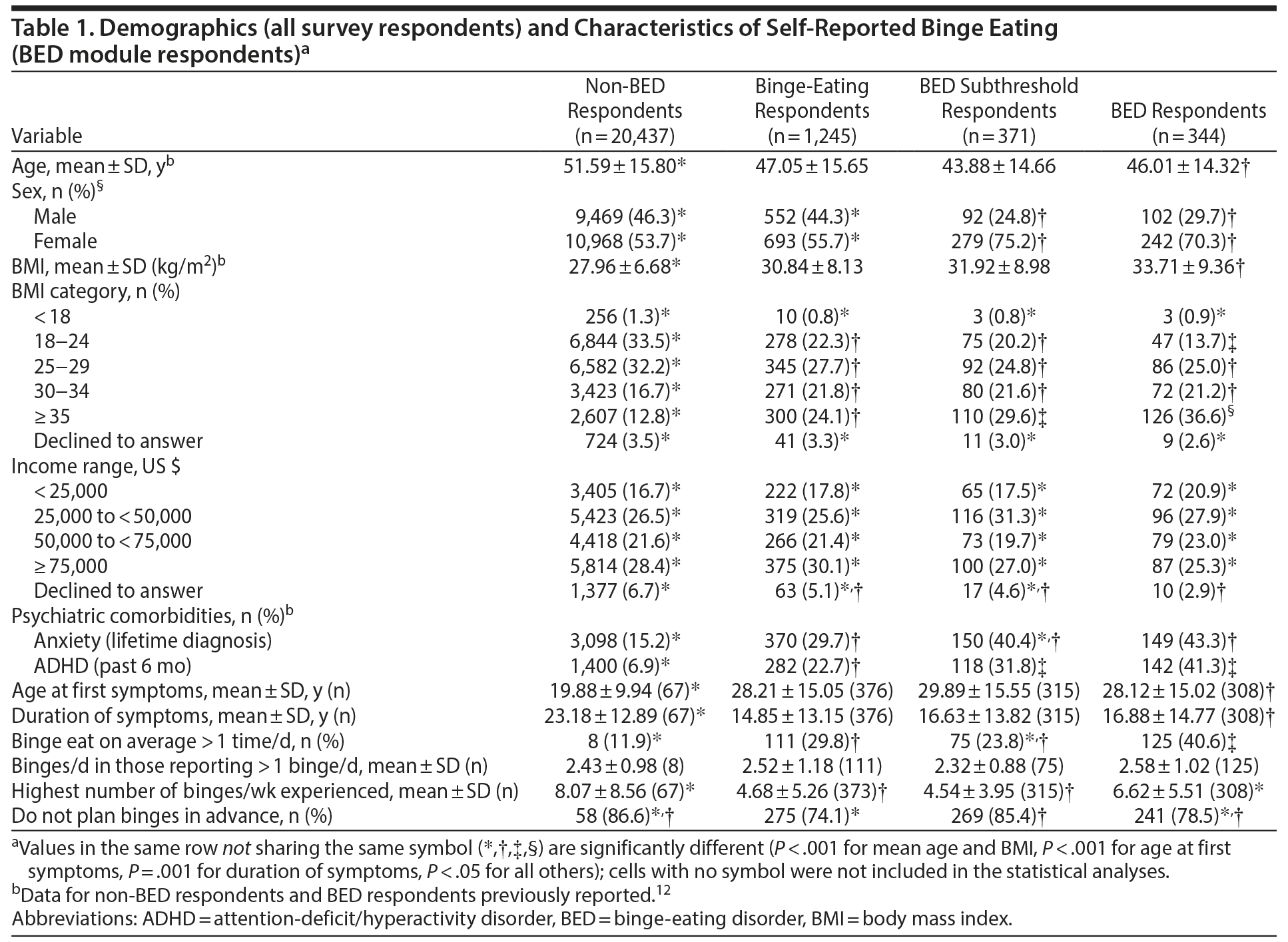
BED Symptom Frequency and Duration
All BED respondents, binge-eating respondents, and BED subthreshold respondents reported consuming amounts of food that were definitely larger than most people would eat and feeling loss of control over eating. None of the non-BED respondents reported loss of control over eating; only 15.7% reported consuming amounts of food that were definitely larger than most people would eat (Table 2). Significantly higher percentages of BED and BED subthreshold respondents reported eating more rapidly than usual, eating until uncomfortably full, eating when not hungry, eating alone because of embarrassment, and feelings of disgust than binge-eating respondents (all P < .05, Table 2). A significantly higher percentage of BED respondents reported extreme distress in association with binge eating than did BED subthreshold or binge-eating respondents (both P < .05, Table 2).
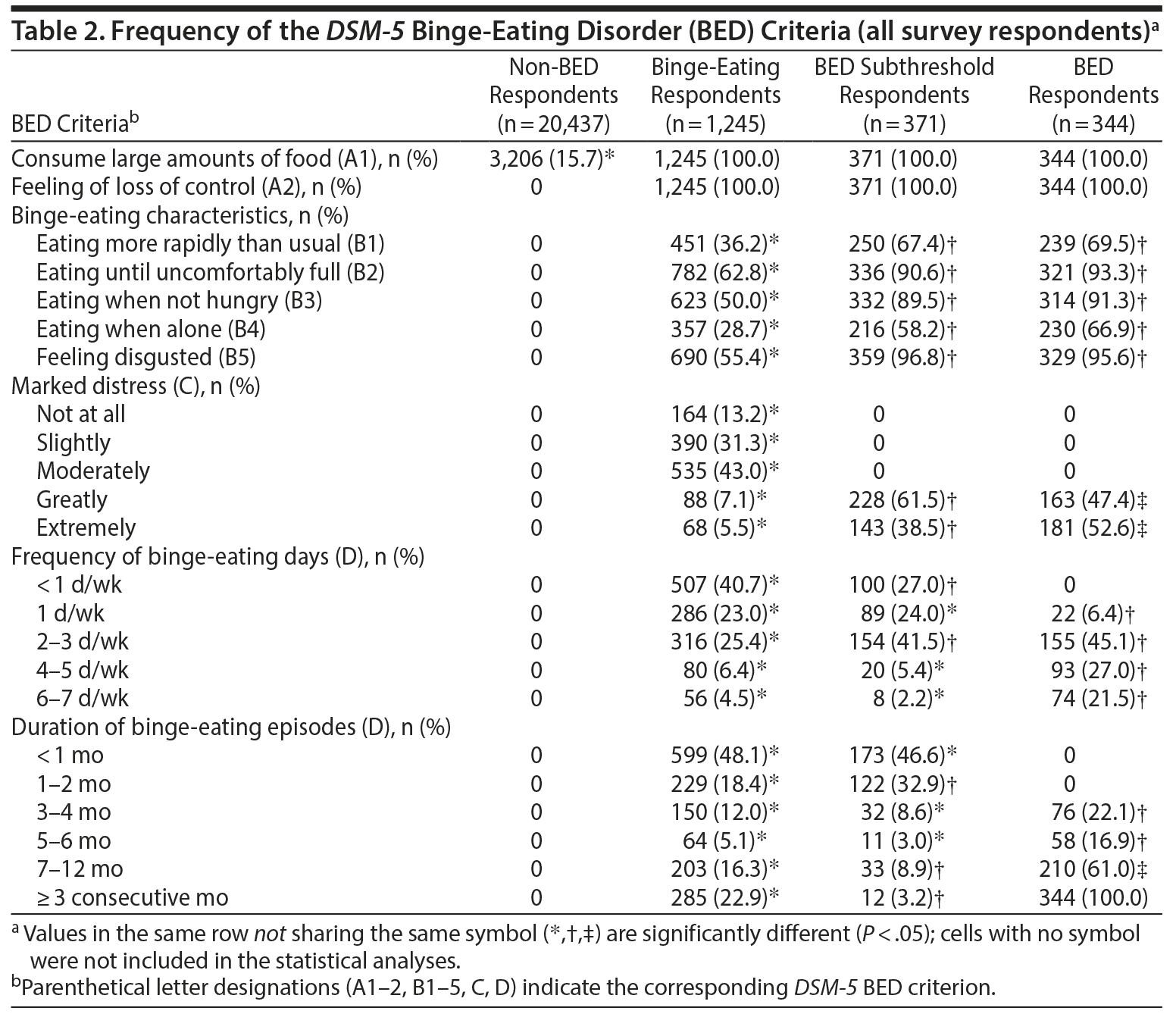
Significantly higher percentages of BED respondents reported that the duration of binge eating was between 3 and 4, 5 and 6, and 7 and 12 months than did BED subthreshold or binge-eating respondents (all P < .05, Table 2), with the majority of BED respondents reporting a duration of 7 to 12 months. A significantly higher percentage of BED subthreshold respondents reported that the duration of binge-eating episodes was between 1 and 2 months, and significantly lower percentages of BED subthreshold respondents reported that the duration of binge-eating episodes was between 7 and 12 and ≥ 3 consecutive months compared with binge-eating respondents (all P < .05).
Significantly higher percentages of BED respondents reported frequencies of binge eating between 2 and 3, 4 and 5, and 6 and 7 days per week than did binge-eating respondents and frequencies of binge eating between 4 and 5 and 6 and 7 days per week than did BED subthreshold respondents (all P < .05, Table 2). A significantly lower percentage of BED subthreshold respondents reported a frequency of binge eating of < 1 day per week, and a significantly higher percentage reported a frequency between 2 and 3 days per week compared with binge-eating respondents (both P < .05, Table 2).
BED Symptom Severity
Across all symptoms, significantly higher percentages of BED respondents reported severe symptoms and significantly lower percentages reported mild symptoms than did BED subthreshold or binge-eating respondents (all P < .05, Figure 1). Significantly higher percentages of BED subthreshold respondents reported that symptoms of eating large amounts of food in 2 hours and loss of control during the binge-eating episode were moderate or severe than did binge-eating respondents (both P < .05, Figure 1). In addition, significantly higher percentages of BED subthreshold respondents than binge-eating respondents reported that symptoms of eating until uncomfortably full, eating when not physically hungry, and feeling disgusted with oneself, depressed, or guilty afterward were severe (all P < .05, Figure 1).
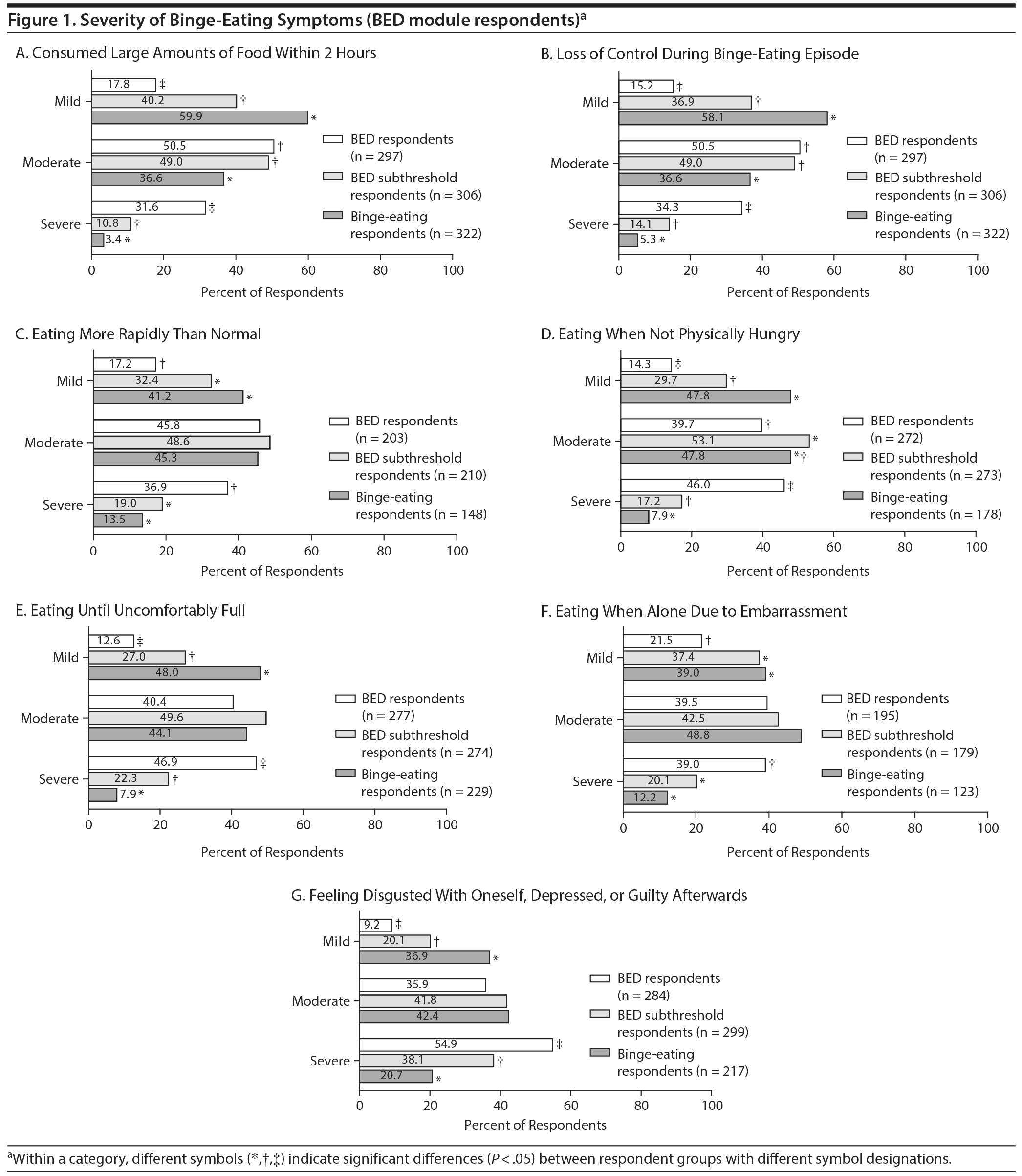
Binge-Eating Characterization in
BED Module Respondents
Compared with non-BED respondents, BED respondents were significantly older when symptoms were first experienced (P < .001), and the length of time symptoms were experienced was significantly shorter (P = .001, Table 1). A greater percentage of BED respondents reported binge eating on average > 1 time per day than did all other respondent groups (all P < .05, Table 1). Greater percentages of BED subthreshold respondents reported binge eating on average > 1 time per day than did non-BED respondents. Respondent groups did not differ statistically in regard to the mean ± SD number of binges per day among those self-reporting > 1 binge day per week. The highest mean ± SD number of binges ever experienced in 1 week was significantly larger in BED respondents (P < .05) than in BED subthreshold or binge-eating respondents but not in non-BED respondents (Table 1). Most respondents reported that binges were not planned in advance (Table 1).
Among respondents who experienced > 1 binge per day, the highest percentage of respondents in each group reported binge eating 2 to 3 times per day (Figure 2A); there were no significant differences among respondent groups. Except for non-BED respondents, the highest percentage of respondents in each group reported that they binge ate on average 31 to 60 or 61 to 90 minutes each day (Figure 2B). Significantly greater percentages of BED, binge-eating, and BED subthreshold respondents reported that they binge ate on average for 31 to 60 minutes than did non-BED respondents (all P < .05, Figure 2B). BED respondents were least likely to report that the most binges per week ranged from 0 to 2 and most likely to report that most binges per week ranged from 5 to ≥ 10 (Figure 2C). Significantly lower percentages of BED, BED subthreshold, and binge-eating respondents reported that the most binges per week was 0 compared with non-BED respondents (all P < .05, Figure 2C).
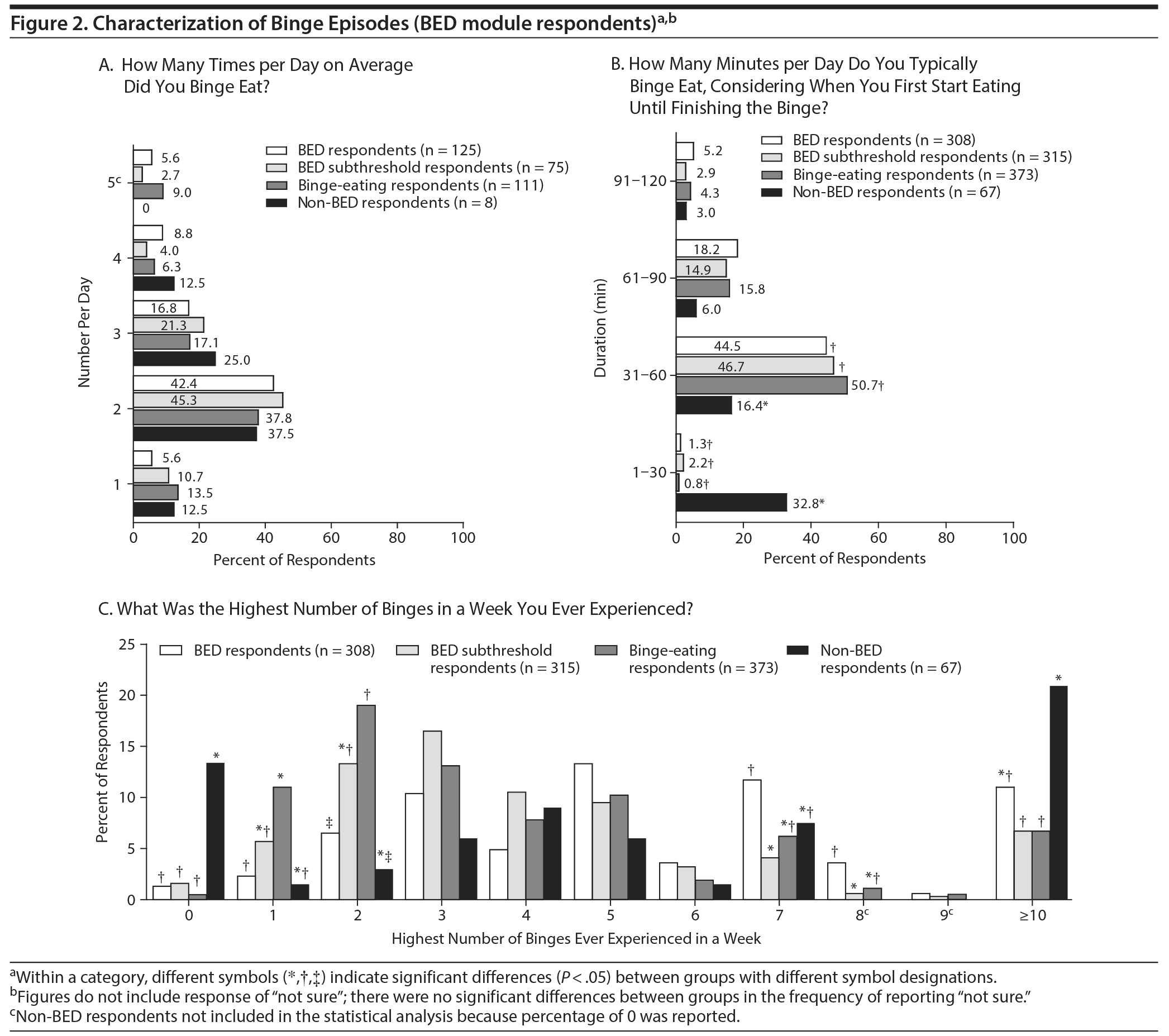
A majority of BED respondents reported the urge to binge eat (very often: 36.6% [126/344], often: 34.0% [117/344]) and actual binge eating (very often: 32.3% [111/344], often: 32.3% [111/344]) between 7 pm and 10 pm (Figures 3A and 3B). Across the entire day, BED respondents rated the urge to binge eat and actual binge eating as higher than non-BED respondents (Figure 3C and 3D, all P ≤ .003).
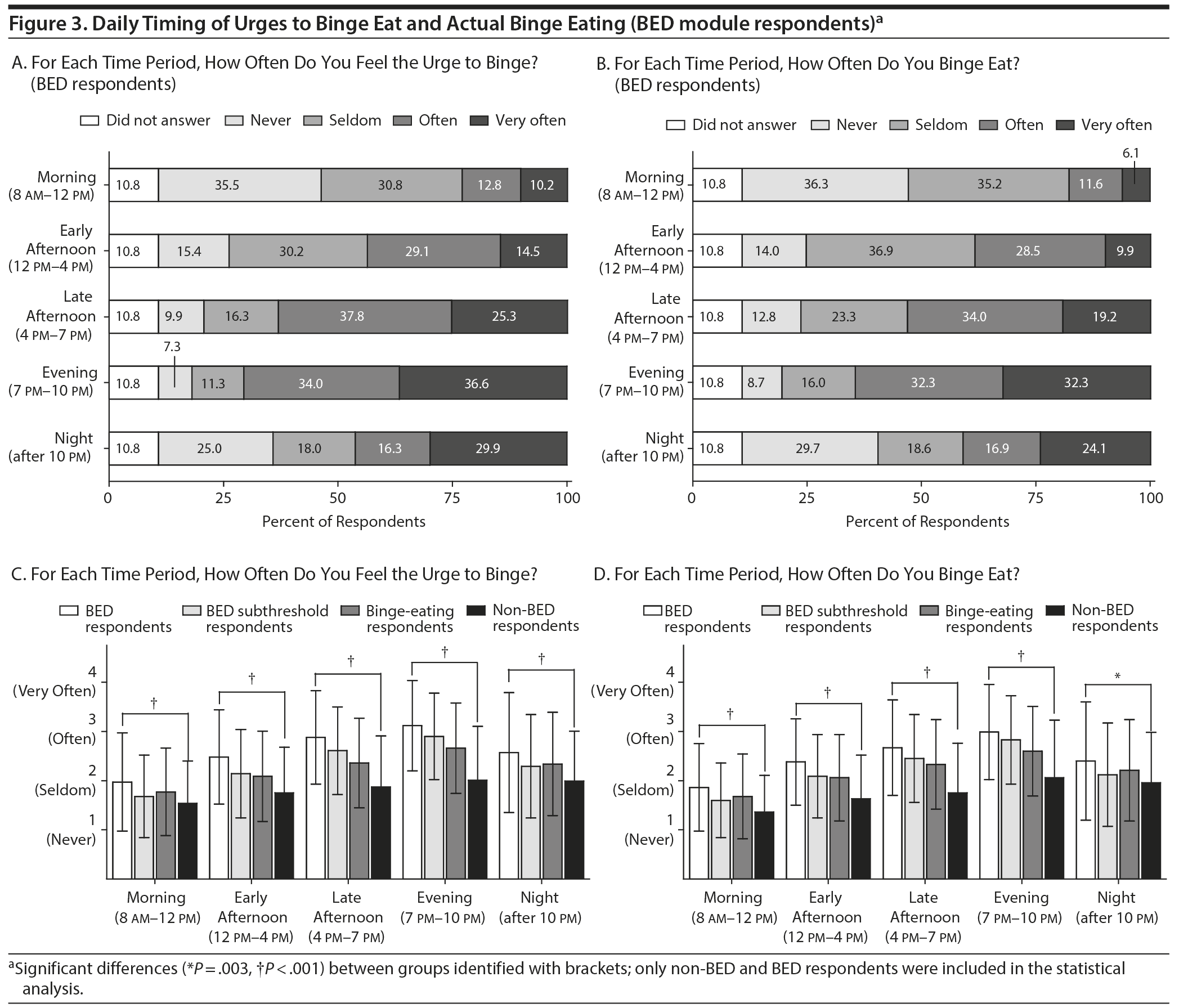
BED respondents reported that the most bothersome symptoms of BED (“very” or “extremely” bothersome, Figure 4A) included feeling disgusted after binge eating, eating until uncomfortably full, and loss of control over eating. With the exception of eating more rapidly than normal, women were more likely than men to rate symptoms as extremely bothersome; the overall ranking of bothersomeness across symptoms did not differ between sexes (Figure 4B). BED respondents rated all symptoms as significantly more bothersome than did BED subthreshold or binge-eating respondents (Figure 4C, all P < .05), with ratings of “very bothersome” or “extremely bothersome” in BED respondents ranging from 36.6% to 66.3% across symptoms. BED subthreshold respondents rated all symptoms as significantly more bothersome than binge-eating respondents (Figure 4C, all P < .05).
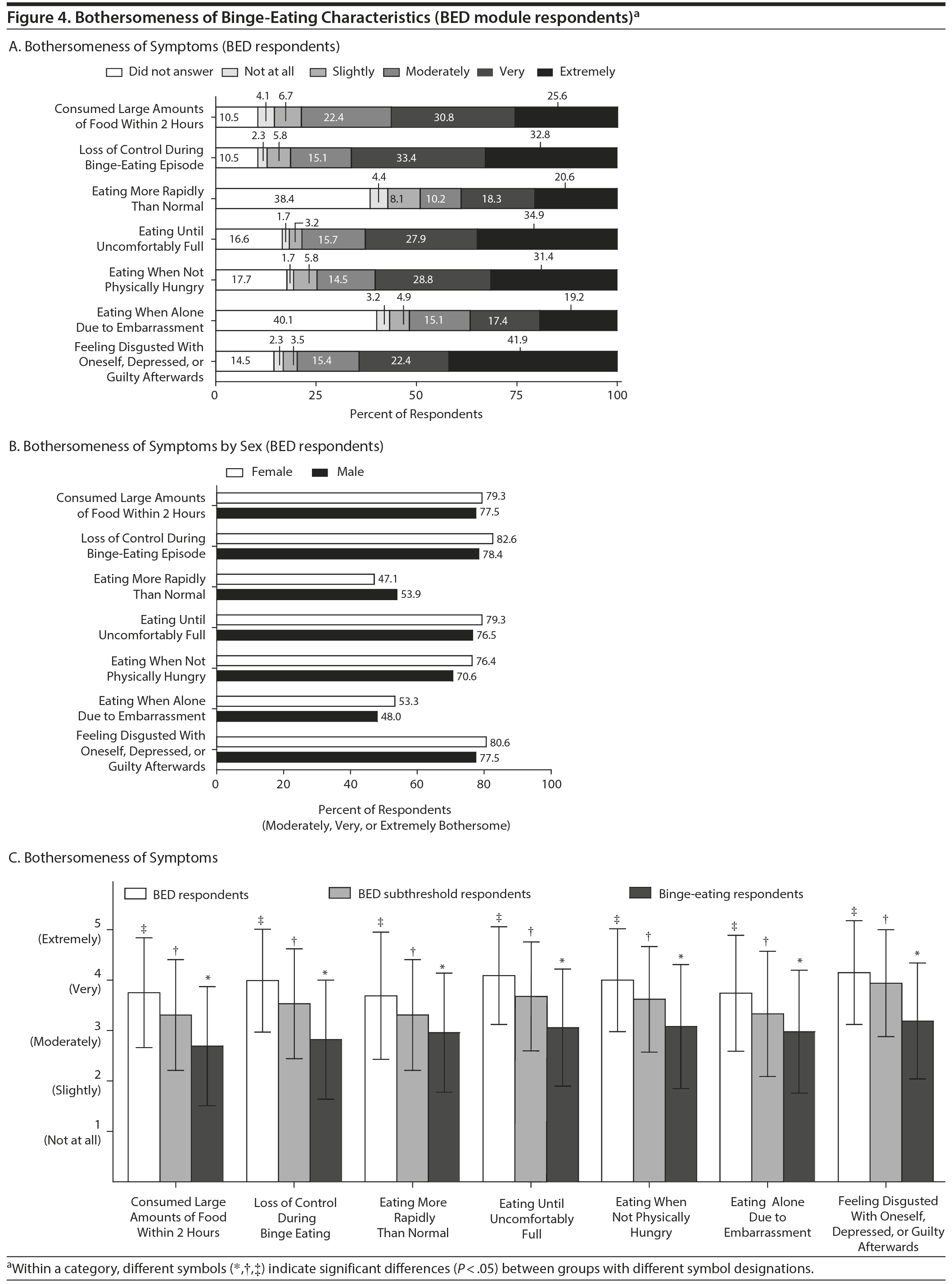
DISCUSSION
To our knowledge, this is the first epidemiology survey to characterize binge-eating behavior in a representative population of US adults who self-report meeting DSM-5 diagnostic criteria for BED. Among most BED respondents, binge eating had occurred for the past 7 to 12 months at a rate of ≥ 2 to 3 binges per week; the duration of binge eating was most often between 31 and 60 minutes. The most common time for the urge to binge and actual binge eating to occur was between 7 pm and 10 pm in BED respondents, with binge eating rarely being planned in advance. BED symptoms reported as most bothersome by BED respondents included feeling disgusted after binge eating, eating until uncomfortably full, and loss of control over eating, with women generally rating BED symptoms as more bothersome than men. These data underscore the burden of binge-eating disorder in this population.
This is also the first study, to our knowledge, comparing the binge-eating behavior and disease burden in individuals meeting DSM-5 diagnostic criteria for BED, individuals who are subthreshold for BED, and non-BED individuals. These data indicate that individuals who self-report meeting DSM-5 BED diagnostic criteria differ on numerous binge-eating dimensions from those who do not self-report meeting full DSM-5 criteria. These differences offer further support for the DSM-5 BED diagnostic criteria. Notably, BED respondents were more likely to report that binge eating had been occurring for ≥ 3 months, binge eating occurred between 4 and 7 days per week, and BED symptoms were severe and more bothersome than BED subthreshold and binge-eating respondents. The highest number of binges per week ever experienced by BED respondents was also greater than that reported for BED subthreshold and binge-eating respondents.
BED subthreshold and binge-eating respondents differed not only from non-BED respondents, but also from each other. BED subthreshold respondents (those who self-reported meeting all DSM-5 BED criteria except for the frequency and duration criterion) and binge-eating respondents (those who self-reported binge-eating episodes with a feeling of loss of control but did not meet the full DSM-5 criteria) exhibited differing profiles of symptom severity, bothersomeness, and distress associated with binge eating. These differing profiles not only support the importance of the marked distress criterion for BED, but also indicate that there are quantitative differences in binge-eating behaviors among individuals who self-report meeting different BED symptom profiles.
The lack of planning associated with binge eating in BED respondents highlights the impulsive and compulsive nature of binge-eating behavior. This finding is consistent with the published literature,23–31 which reports that individuals with BED exhibit more impulsive and compulsive behavior than obese individuals not diagnosed with BED. Studies23–31 report that individuals with BED exhibit increased impulsivity on the Barratt Impulsiveness Scale and UPPS Impulsive Behavior Scale and impaired set-shifting reflective of perseverative and compulsive behaviors compared with non-BED obese individuals and normal-weight individuals.
Although non-BED respondents were least likely to consume large amounts of food and more likely to report shorter binge-eating episode durations, they self-reported the earliest age at first symptoms, the longest symptom duration, and the most binges ever experienced during a week. The reasons for these discrepancies are unclear. However, they may be related to respondent perceptions of what constitutes a binge. Some individuals may eat a small or moderate amount of food and perceive it as large. Evidence of such a perceptual difference in regard to binge eating has been reported32 and emphasizes the need to clearly define what constitutes a binge. If true, comparisons between the non-BED and other respondent groups regarding binge-eating characteristics should be considered cautiously.
The key strengths of this study are that it used DSM-5 diagnostic criteria for BED and consisted of a large, representative US adult population with respect to age, sex, and race/ethnicity. However, the data are based on self-report and are from an Internet-based survey, so their generalizability may be limited.
In conclusion, these data indicate that binge-eating frequency varied in BED respondents but on average occurred more than 2 or 3 days per week and had been occurring for 7 to 12 months. In BED respondents, binge-eating symptoms were often severe. Further, there were distinctions between BED respondents and respondents who did not meet all BED diagnostic criteria. BED respondents reported that symptoms were more severe and more bothersome. These data highlight the disease burden in individuals with BED and have potential implications for diagnosing and treating BED in the clinical setting.
Submitted: April 15, 2016; accepted August 4, 2016.
Published online: October 27, 2016.
Potential conflicts of interest: Dr Pawaskar is a former employee of Shire and a current employee of Merck and holds stock and/or stock options in Shire and Merck. Dr Herman is an employee of Shire and holds stock and/or stock options in Shire. Messrs Solo and Valant are principal owners of Lexidyne. Ms Schmitt is a former employee of Lexidyne. Ms Nwankwo is a former consultant for Shire.
Funding/support: This research was funded by the sponsor, Shire Development LLC (Lexington, Massachusetts), and conducted by Kantar Health (Horsham, Pennsylvania), with additional analyses provided by Lexidyne LLC (Colorado Springs, Colorado). The sponsor also provided funding to Complete Healthcare Communications, LLC (CHC; Chadds Ford, Pennsylvania) for support in writing and editing of this manuscript. Under the direction of the authors, writing assistance was provided by Stefan Kolata, PhD (a former employee of CHC) and Craig Slawecki, PhD (a current employee of CHC). Editorial assistance in the form of proofreading, copy editing, and fact checking was also provided by CHC.
Role of the sponsor: The study sponsor, Shire Development LLC, was involved in the design and conduct of the study and in the collection, analysis, and interpretation of the data. The final content of this manuscript, the ultimate data interpretation, and the decision to submit the manuscript for publication in The Primary Care Companion for CNS Disorders were made by the authors independently.
Previous presentation: These data were presented at the 168th Annual Meeting of the American Psychiatric Association; May 16–20, 2015; Toronto, Ontario, Canada.
Acknowledgments: The authors would like to acknowledge Edward A. Witt, PhD (Kantar Health, Horsham, Pennsylvania) for his contribution to the design, analysis, and data collection of the VALIDATE study and Carlos Grilo, PhD (Program for Obesity, Weight and Eating Research, Yale School of Medicine, New Haven, Connecticut) for his insightful comments on the initial draft of this manuscript.
REFERENCES
1. Stunkard AJ. Eating patterns and obesity. Psychiatr Q. 1959;33:284–295. PubMed doi:10.1007/BF01575455
2. Spitzer RL, Stunkard A, Yanovski S, et al. Binge eating disorder should be included in DSM-IV: a reply to Fairburn et al.’s “The classification of recurrent overeating: the binge eating disorder proposal.” Int J Eat Disord. 1993;13(2):161–169. PubMed doi:10.1002/1098-108X(199303)13:2<161::AID-EAT2260130204>3.0.CO;2-R
3. Spitzer RL. Nonpurging bulimia nervosa and binge eating disorder. Am J Psychiatry. 1991;148(8):1097–1098. PubMed doi:10.1176/ajp.148.8.1097-a
4. Spitzer RL, Yanovski S, Wadden T, et al. Binge eating disorder: its further validation in a multisite study. Int J Eat Disord. 1993;13(2):137–153. PubMed
5. American Psychiatric Association. Diagnostic and Statistical Manual of Mental Disorders. Fifth Edition. Washington, DC: American Psychiatric Association; 2013.
6. American Psychiatric Association. Diagnostic and Statistical Manual of Mental Disorders. Fourth Edition, Text Revision. Washington, DC: American Psychiatric Association; 2000.
7. Yanovski SZ. Binge eating disorder: current knowledge and future directions. Obes Res. 1993;1(4):306–324. PubMed doi:10.1002/j.1550-8528.1993.tb00626.x
8. Wilson GT, Sysko R. Frequency of binge eating episodes in bulimia nervosa and binge eating disorder: diagnostic considerations. Int J Eat Disord. 2009;42(7):603–610. PubMed doi:10.1002/eat.20726
9. Hudson JI, Hiripi E, Pope HG Jr, et al. The prevalence and correlates of eating disorders in the National Comorbidity Survey Replication. Biol Psychiatry. 2007;61(3):348–358. PubMed doi:10.1016/j.biopsych.2006.03.040
10. Kessler RC, Berglund PA, Chiu WT, et al. The prevalence and correlates of binge eating disorder in the World Health Organization World Mental Health Surveys. Biol Psychiatry. 2013;73(9):904–914. PubMed doi:10.1016/j.biopsych.2012.11.020
11. Hudson JI, Coit CE, Lalonde JK, et al. By how much will the proposed new DSM-5 criteria increase the prevalence of binge eating disorder? Int J Eat Disord. 2012;45(1):139–141. PubMed doi:10.1002/eat.20890
12. Cossrow N, Pawaskar M, Witt EA, et al. Estimating the prevalence of binge eating disorder in a community sample from the United States: comparing DSM-IV-TR and DSM-5 criteria. J Clin Psychiatry. 2016 Aug;77(8):e968–974. doi:10.4088/JCP.15m10059 PubMed
13. Guss JL, Kissileff HR, Devlin MJ, et al. Binge size increases with body mass index in women with binge-eating disorder. Obes Res. 2002;10(10):1021–1029. PubMed doi:10.1038/oby.2002.139
14. Yanovski SZ, Leet M, Yanovski JA, et al. Food selection and intake of obese women with binge-eating disorder. Am J Clin Nutr. 1992;56(6):975–980. PubMed
15. Raymond NC, Bartholome LT, Lee SS, et al. A comparison of energy intake and food selection during laboratory binge eating episodes in obese women with and without a binge eating disorder diagnosis. Int J Eat Disord. 2007;40(1):67–71. PubMed doi:10.1002/eat.20312
16. Bartholome LT, Peterson RE, Raatz SK, et al. A comparison of the accuracy of self-reported intake with measured intake of a laboratory overeating episode in overweight and obese women with and without binge eating disorder. Eur J Nutr. 2013;52(1):193–202. PubMed doi:10.1007/s00394-012-0302-z
17. Allison KC, Wadden TA, Sarwer DB, et al. Night eating syndrome and binge eating disorder among persons seeking bariatric surgery: prevalence and related features. Surg Obes Relat Dis. 2006;2(2):153–158. PubMed doi:10.1016/j.soard.2006.03.014
18. Pollert GA, Engel SG, Schreiber-Gregory DN, et al. The role of eating and emotion in binge eating disorder and loss of control eating. Int J Eat Disord. 2013;46(3):233–238. PubMed doi:10.1002/eat.22061
19. White MA, Grilo CM. Diagnostic efficiency of DSM-IV indicators for binge eating episodes. J Consult Clin Psychol. 2011;79(1):75–83. PubMed doi:10.1037/a0022210
20. Grilo CM, White MA. A controlled evaluation of the distress criterion for binge eating disorder. J Consult Clin Psychol. 2011;79(4):509–514. PubMed doi:10.1037/a0024259
21. Bolge SC, Doan JF, Kannan H, et al. Association of insomnia with quality of life, work productivity, and activity impairment. Qual Life Res. 2009;18(4):415–422. PubMed doi:10.1007/s11136-009-9462-6
22. DiBonaventura MD, Wagner JS, Yuan Y, et al. Humanistic and economic impacts of hepatitis C infection in the United States. J Med Econ. 2010;13(4):709–718. PubMed doi:10.3111/13696998.2010.535576
23. Galanti K, Gluck ME, Geliebter A. Test meal intake in obese binge eaters in relation to impulsivity and compulsivity. Int J Eat Disord. 2007;40(8):727–732. PubMed doi:10.1002/eat.20441
24. Manwaring JL, Green L, Myerson J, et al. Discounting of various types of rewards by women with and without binge eating disorder: evidence for general rather than specific differences. Psychol Rec. 2011;61(4):561–582. PubMed
25. Schag K, Teufel M, Junne F, et al. Impulsivity in binge eating disorder: food cues elicit increased reward responses and disinhibition. PLoS One. 2013;8(10):e76542. PubMed doi:10.1371/journal.pone.0076542
26. Wu M, Giel KE, Skunde M, et al. Inhibitory control and decision making under risk in bulimia nervosa and binge-eating disorder. Int J Eat Disord. 2013;46(7):721–728. PubMed doi:10.1002/eat.22143
27. Danner UN, Ouwehand C, van Haastert NL, et al. Decision-making impairments in women with binge eating disorder in comparison with obese and normal weight women. Eur Eat Disord Rev. 2012;20(1):e56–e62. PubMed doi:10.1002/erv.1098
28. Fineberg NA, Chamberlain SR, Goudriaan AE, et al. New developments in human neurocognition: clinical, genetic, and brain imaging correlates of impulsivity and compulsivity. CNS Spectr. 2014;19(1):69–89. PubMed doi:10.1017/S1092852913000801
29. Wu M, Brockmeyer T, Hartmann M, et al. Set-shifting ability across the spectrum of eating disorders and in overweight and obesity: a systematic review and meta-analysis. Psychol Med. 2014;44(16):3365–3385. PubMed doi:10.1017/S0033291714000294
30. Duchesne M, Mattos P, Appolinário JC, et al. Assessment of executive functions in obese individuals with binge eating disorder. Rev Bras Psiquiatr. 2010;32(4):381–388. PubMed doi:10.1590/S1516-44462010000400011
31. Hege MA, Stingl KT, Kullmann S, et al. Attentional impulsivity in binge eating disorder modulates response inhibition performance and frontal brain networks. Int J Obes (Lond). 2015;39(2):353–360. PubMed doi:10.1038/ijo.2014.99
32. Beglin SJ, Fairburn CG. What is meant by the term “binge”? Am J Psychiatry. 1992;149(1):123–124. PubMed doi:10.1176/ajp.149.1.123
This PDF is free for all visitors!


